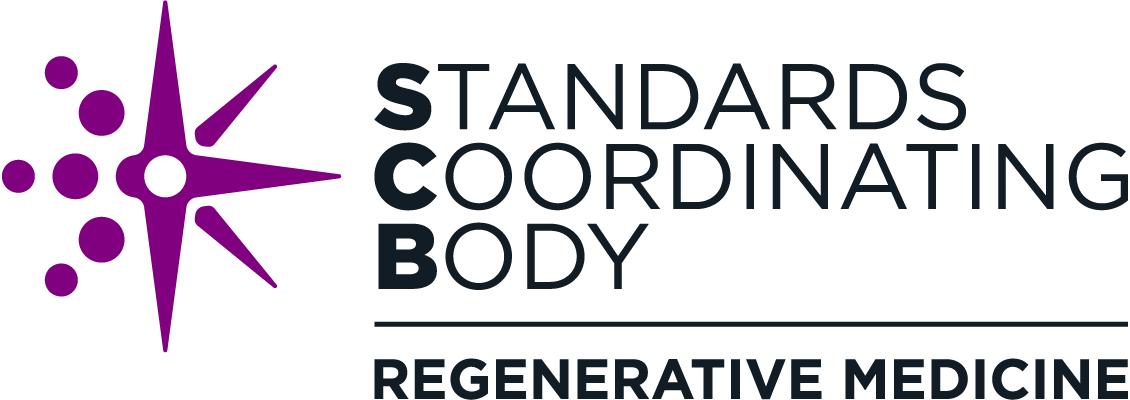Guidance and Regulations
Standards development requires close interaction with federal agencies that issue guidance documents and regulations:
Guidance: Formal statements of federal government agency policy with respect to laws or regulations
Regulations: Have the force and effect of law and are generally mandatory, setting out specific requirements that regulated products and entities must meet. In the United States, regulations are written (codified) in the Code of Federal Regulations (CFR) and published in the Federal Register (FR).
Learn more about how government agencies support and interact with standards in our Guide to Standards Terminology.
The following guidance documents and regulations are relevant to the regenerative medicine standards landscape.
Crosscutting
FDA CBER Recognition Program for Voluntary Consensus Standards
FDA’s Center for Biologics Evaluation and Research (CBER) developed draft guidance on an upcoming program for recognition of certain voluntary standards for biological medicines, including regenerative medicine products. The standards recognition program is intended to help regenerative medicine stakeholders identify standards FDA will accept in regulatory submissions.
SCB is helping the community prepare for the launch of this program with helpful content:
FDA DRAFT GUIDANCE: THE PROGRAM FOR THE RECOGNITION OF VOLUNTARY CONSENSUS STANDARDS RELATED TO PHARMACEUTICAL QUALITY
This 2019 draft guidance issued by the Center for Drug Evaluation and Research (CDER) describes a proposed program at CDER to make a comprehensive listing of informally recognized voluntary standards related to pharmaceutical quality. The program, once established, will help promote innovation in pharmaceutical development and manufacturing and streamline the compilation and assessment of marketing applications for products regulated by CDER.
FDA GUIDANCE: STANDARDS DEVELOPMENT AND THE USE OF STANDARDS IN REGULATORY SUBMISSIONS
This 2019 final guidance issued by the Center for Biologics Evaluation and Research (CBER) describes what standards are and how they are developed by standards developing organizations (SDOs). The guidance also addresses questions on how sponsors can use standards to facilitate product development and regulatory submissions and acceptance of such use of standards by the U.S. Food and Drug Administration (FDA).
FDA GUIDANCE FOR INDUSTRY: EXPEDITED PROGRAMS FOR REGENERATIVE MEDICINE THERAPIES FOR SERIOUS CONDITIONS
This 2019 final CBER guidance identifies expedited programs available for those that develop regenerative medicine therapies for serious or life-threatening conditions. It also identifies factors important during the development of regenerative medicine therapies and opportunities for interacting with the CBER review staff to obtain nonbinding regulatory advice during the product development process.
FDA GUIDANCE FOR INDUSTRY: EVALUATION OF DEVICES USED WITH REGENERATIVE MEDICINE ADVANCED THERAPIES
This 2019 final guidance jointly issued by CBER, the Center for Devices and Radiological Health (CDRH), and the Office of Combination Products (OCP) fulfills a statutory requirement in the 21st Century Cures Act (Cures Act) by describing how FDA intends to simplify and streamline its application of regulatory requirements for combination devices and cell or tissue regenerative medicine advanced therapies (RMAT).
FDA GUIDANCE FOR INDUSTRY: DEVIATION REPORTING FOR HUMAN CELLS, TISSUES, AND CELLULAR AND TISSUE-BASED PRODUCTS REGULATED SOLELY UNDER SECTION 361 OF THE PUBLIC HEALTH SERVICE ACT AND 21 CFR PART 1271
This 2017 final CBER guidance provides information for sponsors who manufacture human cells, tissues, and cellular and tissue-based products (HCT/Ps). The guidance includes recommendations and examples for investigating and reporting deviations from applicable regulations and standards to CBER.
FDA GUIDANCE FOR INDUSTRY AND FDA STAFF: REGULATORY CONSIDERATIONS FOR HUMAN CELL, TISSUES, AND CELLULAR AND TISSUE-BASED PRODUCTS: MINIMAL MANIPULATION AND HOMOLOGOUS USE
This 2017 final guidance jointly issued by CDRH and CBER identifies the criteria and definitions for minimal manipulation and homologous use of HCT/Ps.
FDA GENERAL GUIDANCE: SAME SURGICAL PROCEDURE EXCEPTION UNDER 21 CFR 1271.15(B): QUESTIONS AND ANSWERS REGARDING THE SCOPE OF THE EXCEPTION
This 2017 final CBER guidance provides information in a question-and-answer format to clarify the exception from the requirements under 21 CFR Part 1271 described in Part 1271.15(b) regarding establishments that remove and insert HCT/Ps into the same individual during a single surgical procedure.
FDA GUIDANCE FOR INDUSTRY: INVESTIGATING AND REPORTING ADVERSE REACTIONS RELATED TO HUMAN CELLS, TISSUES, AND CELLULAR AND TISSUE-BASED PRODUCTS (HCT/Ps) REGULATED SOLELY UNDER SECTION 361 OF THE PUBLIC HEALTH SERVICES ACT AND 21 CFR PART 1271
This 2016 final CBER guidance supports sponsors in investigating and reporting adverse reactions that occur from HCT/Ps regulated under section 361 of the Public Health Service Act (PHS) and 21 CFR Part 1271.
FDA GUIDANCE FOR INDUSTRY: CURRENT GOOD TISSUE PRACTICE (CGTP) AND ADDITIONAL REQUIREMENTS FOR MANUFACTURERS OF HUMAN CELLS, TISSUES, AND CELLULAR AND TISSUE-BASED PRODUCTS (HCT/Ps)
This 2011 final CBER guidance clarifies the listing requirements for HCT/Ps and provides recommendations for the implementation of CGTP requirements.
FDA GENERAL GUIDANCE: REGULATION OF HUMAN CELLS, TISSUES, AND CELLULAR AND TISSUE-BASED PRODUCTS (HCT/PS) - SMALL ENTITY COMPLIANCE GUIDE
This final 2007 CBER guidance is intended to help small organizations that develop HCT/Ps better understand and comply with the broad regulatory framework surrounding their products.
FDA GUIDANCE FOR INDUSTRY: PAT — A FRAMEWORK FOR INNOVATIVE PHARMACEUTICAL DEVELOPMENT, MANUFACTURING, AND QUALITY ASSURANCE
This 2004 final guidance jointly issued by CDER, the Center for Veterinary Medicine, and the Office of Regulatory Affairs describes the Process Analytical Technology (PAT) regulatory framework. The framework is intended to encourage the voluntary development and implementation of innovative pharmaceutical development, manufacturing, and quality assurance.
Gene Therapy
FDA DRAFT GUIDANCE FOR INDUSTRY: INTERPRETING SAMENESS OF GENE THERAPY PRODUCTS UNDER THE ORPHAN DRUG REGULATIONS
This 2020 draft CBER guidance is intended to support stakeholders in the regenerative medicine industry who request orphan-drug designation and orphan-drug exclusivity for the development of gene therapies for rare diseases. The draft guidance focuses on factors FDA considers when reviewing gene therapy products and does not address other products.
FDA GUIDANCE FOR INDUSTRY: HUMAN GENE THERAPY FOR HEMOPHILIA
This 2020 final CBER guidance is intended to provide recommendations for sponsors of gene therapy products for hemophilia. The guidance addresses clinical trial design and the development of coagulation factor VIII (hemophilia A) and IX (hemophilia B) activity assays. The guidance also provides recommendations for the development of gene therapy products that treat hemophilia.
FDA GUIDANCE FOR INDUSTRY: HUMAN GENE THERAPY FOR RARE DISEASES
This 2020 final CBER guidance provides recommendations for manufacturing, preclinical, and clinical trial design processes for developing gene therapy products that treat rare diseases.
FDA GUIDANCE FOR INDUSTRY: HUMAN GENE THERAPY FOR RETINAL DISORDERS
This 2020 final CBER guidance provides recommendations for the product development, preclinical testing, and clinical trial design of gene therapy products that treat retinal disorders.
FDA GUIDANCE FOR INDUSTRY: CHEMISTRY, MANUFACTURING, AND CONTROL (CMC) INFORMATION FOR HUMAN GENE THERAPY INVESTIGATIONAL NEW DRUG APPLICATIONS (INDs)
This 2020 final CBER guidance identifies CMC information that must be submitted in an IND. This information is required for the safety, identity, quality, purity, and strength of the investigational product.
FDA GUIDANCE FOR INDUSTRY: LONG TERM FOLLOW-UP AFTER ADMINISTRATION OF HUMAN GENE THERAPY PRODUCTS
This 2020 final CBER guidance provides recommendations to support the development of long-term follow-up (LTFU) studies after gene therapy products are administered. The guidance also identifies risk assessment strategies to identify which gene therapy products will require LTFUs to identify delayed adverse effects.
FDA GUIDANCE FOR INDUSTRY: TESTING OF RETROVIRAL VECTOR-BASED HUMAN GENE THERAPY PRODUCTS FOR REPLICATION COMPETENT RETROVIRUS DURING PRODUCT MANUFACTURE AND PATIENT FOLLOW-UP
This 2020 final CBER guidance supports testing for replication-competent retrovirus (RCR) and associated pathogenicity following the administration of a vector-based human gene therapy product. The guidance provides recommendations on testing methods, the amount of material to gather, and monitoring practices to identify a retroviral infection.
TITLE 21 SUBCHAPTER F: BIOLOGICS (21 CFR PARTS 600–680)
Title 21 Subchapter F addresses general requirements related to biological products, including good manufacturing practices for blood and blood components, product and diagnostic testing standards, and other key considerations.
TITLE 21 CFR 610.12: FDA STERILITY REGULATION
Title 21 CFR Part 610.12 amends previous sterility test requirements for biological products. It provides manufacturers of biological products greater flexibility, as appropriate, and encourages the use of the most appropriate and state-of-the-art testing methods for assuring the safety of biological products.
TITLE 21 CFR PART 1271: HUMAN CELLS, TISSUES, AND CELLULAR AND TISSUE-BASED PRODUCTS
21 CFR Part 1271 addresses requirements related to HCT/Ps, including general provisions, procedures for registration and listing, donor eligibility, CGTPs, and other considerations.
21 U.S. CODE § 356G: STANDARDS FOR REGENERATIVE MEDICINE AND REGENERATIVE ADVANCED THERAPIES
21 U.S.C. § 356g outlines the coordinated effort among the Secretary of U.S. Health and Human Services, the National Institute of Standards and Technology (NIST), and regenerative medicine stakeholders to prioritize the development of standards and consensus definitions.
EMA/CAT/CPWP/686637/2011: RISK-BASED APPROACH ACCORDING TO ANNEX I, PART IV OF DIRECTIVE 2001/83/EC APPLIED TO ADVANCED THERAPY MEDICINAL PRODUCTS
This European Medicines Agency (EMA) Committee for Advanced Therapies (CAT) guideline identifies a risk-based approach to evaluate potential risks associated with Advanced Therapy Medicinal Products (ATMPs) like gene therapy medicinal products (GTMPs), somatic cell therapy medicinal products (sCTMPs), tissue engineering products (TEPs), and other combined ATMPs.
EMEA/CHMP/GTWP/60436/2007: GUIDELINE ON FOLLOW-UP OF PATIENTS ADMINISTERED WITH GENE THERAPY MEDICINAL PRODUCTS
This European Medicines Evaluation Agency (EMEA) Committee for Medicinal Product for Human Use (CHMP) guideline provides recommendations for the clinical monitoring and follow-up of patients after treatment with gene therapy products in order to detect early or delayed signals of adverse reactions and ensure timely treatment.
EMEA/CHMP/410869/2006: GUIDELINE ON HUMAN CELL-BASED MEDICINAL PRODUCTS
This CHMP guideline is intended to address the development, manufacturing, and quality control for the non-clinical and clinical development of cell-based medicinal products (CBMP).
EMEA/CHMP/GTWP/125459/2006: GUIDELINE ON THE NON-CLINICAL STUDIES REQUIRED BEFORE FIRST CLINICAL USE OF GENE THERAPY MEDICINAL PRODUCTS
This CHMP guideline defines scientific principles and provides guidance for applicants developing GTMPs.

